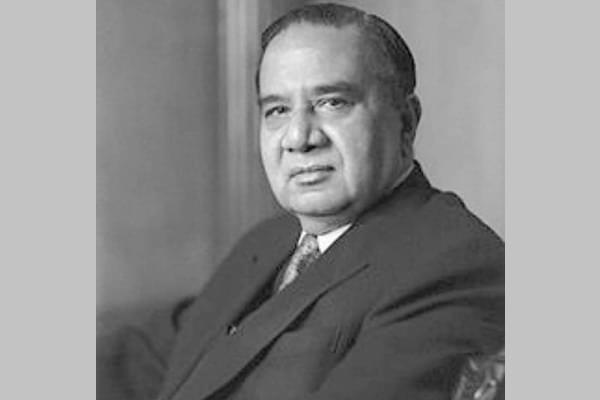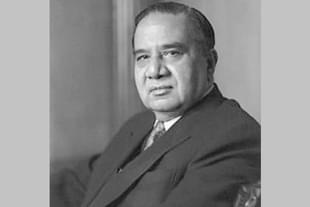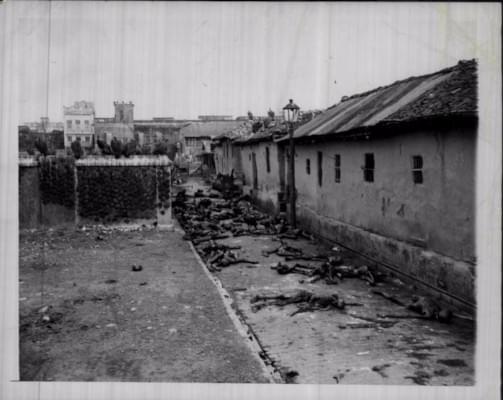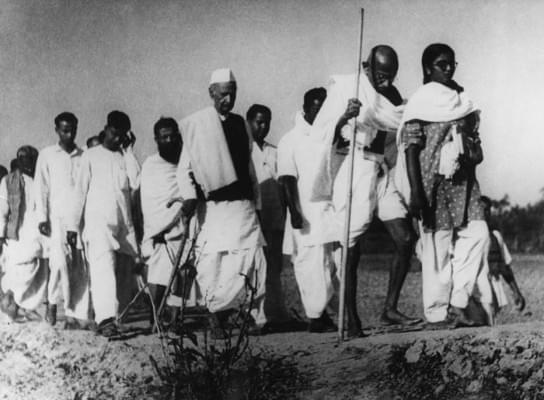Politics
‘The Butcher Of Bengal’ And His Role In Direct Action Day
Jaideep Mazumdar
Aug 21, 2017, 01:02 PM | Updated 01:02 PM IST
Save & read from anywhere!
Bookmark stories for easy access on any device or the Swarajya app.


--
Editorial Note:
We Erred.
While this article primarily focuses on the pivotal role played by Husseyn Shaheed Suhrawardy in fanning the violence during the Direct Action Day, facts of which are beyond any dispute, it concluded by making a call for renaming an arterial road in Kolkata which the author believed was named after Husseyn Shaheed Suhrawardy. The headline was based on the premise that the road was named after him.
After the piece was published, several alert users have pointed out that the road was actually named after Sir Hassan Suhrawardy who was the Vice Chancellor of Calcutta University.
We had immediately placed the relevant portions of the article under review in our website, and sought an explanation from the author.
The author's explanation was placed before our review panel. The author mentioned that a request was made in 1978-79 by the Govt. of Bangladesh to name a road after Mr. HS Suhrawardy. The author will file an RTI to ascertain the facts. Our editorial team reviewed the explanation and came to the conclusion that it does not justify the headlining.
We have updated the headline suitably, and edited relevant portions of the article to rectify the same.
We sincerely apologise for the error and we will continue to strengthen our internal processes to ensure such errors are avoided in future.
--
On this day exactly 71 years ago, Kolkata (then Calcutta) experienced its most violent convulsions. The infamous ‘week of long knives’ – an unprecedented orgy of loot, murder, rapes and molestation let loose on the city’s unsuspecting Hindus by Muslim League strongmen and goons that left 5,000 people dead, tens of thousands maimed and an estimated 1.2 lakh homeless – started with the call for ‘direct action’ on 16 August 1946 by League supremo Muhammad Ali Jinnah.
The Butcher of Bengal
And Calcutta was the only city where Muslim League goons started attacking Hindus on that day. The attack was orchestrated by the diabolic Huseyn Shaheed Suhrawardy, the then chief minister of Bengal, with the sole intention of terrorising Hindus and forcing them to accept Bengal’s inclusion into the proposed Pakistan. He engineered the killings, maiming, rape and molestation of tens of thousands of Hindus in Calcutta, prevented the police from going to the aid of Hindus and then triggered the Noakhali riots in October-November that year that left an estimated 5,000 Hindus dead, while 10,000 were raped and forcibly converted to Islam along with a few thousand Hindu families.
Since 1947, Marxist and Nehruvian historians and scholars have successfully whitewashed the grave crimes of Suhrawardy and made him a respectable figure. Few people know that Suhrawardy, who went on to become Pakistan’s prime minister, is actually the ‘butcher of Bengal’. It is, thus, necessary to revisit history and set the record straight on Suhrawardy as well as his murderous Muslim League colleagues.
Suhrawardy’s Plan
United Bengal was then a Muslim-majority province with only 42 per cent Hindus, but Calcutta had 64 per cent Hindus and 33 per cent Muslims. Bengal was the only province in British India where a Muslim League government was in power. Jinnah’s call for the creation of Pakistan found an ardent advocate in Suhrawardy, who wanted the entire Bengal and Assam to become part of Pakistan. He was desperate to include Hindu-majority Calcutta and some of its Hindu-majority neighbouring districts into Pakistan. Calcutta was, even then, the first city of British India and would have been a prized pick for the proposed Pakistan nation. But since Hindus were in a majority in the city and its neighbouring districts, they would, Suhrawardy felt, have to be reduced to a minority through killings and large-scale riots and then beaten into submission.

In early 1946, British prime minister Clement Attlee sent a three-member Cabinet Mission to finalise the formalities for the transfer of power. On 16 June 1946, the Mission, under pressure from Jinnah, proposed an alternate plan for the sub-continent to be partitioned into a Hindu-majority India and a Muslim-majority Pakistan. Congress rejected the plan outright and, on 10 July, Nehru announced that while the Congress had agreed to participate in the Constituent Assembly, it would be free to change or modify the Cabinet Mission Plan as it thought best.
Jinnah’s Call for ‘Direct Action’
Jinnah construed this as the Congress, in the Hindu-majority Constituent Assembly, declaring its intent to reject the partition of the sub-continent and keeping Muslims under Hindu domination. He convened a meeting of the Muslim League Working Committee on 29 July and got it to pass two resolutions: (a) withdrawal of the Muslim League’s acceptance of the Cabinet Mission Plan of 16 June, and (b) announcement of the ‘Direct Action’ programme. The Muslim League, he explained, would “stop cooperating with the government and bid goodbye to Constitutional methods”.
The Islamist Connection
Jinnah further declared that he was going to “create trouble” and pledged “I will have India divided or India burned”. He gave a call for ‘Direct Action Day’ on 16 August 1946, where Muslims would observe a hartal (general strike) to demonstrate to the British their resolve for the creation of Pakistan. In what gives the lie to later claims that Jinnah was tolerant and secular, and exposes him as a bigoted Islamist, he chose 16 August deliberately. That day in 1946 was the eighteenth day of Ramzan, and it was on that day that Prophet Muhammad waged the bloody Battle of Badr which resulted in his first decisive victory over the heathens and the subsequent conquest of Mecca. Islamists celebrate the victory in this battle as a decisive one for Islam.
Suhrawardy and his Muslim League colleagues delivered fiery speeches reminding Muslims of Bengal of the victory of Badr and exhorting on them to follow in the footsteps of the Prophet and wrest a victory for Islam on 16 August. Devendra Panigrahi, in his seminal India’s Partition: The Story of Imperialism in Retreat, quotes the 13 August 1946 issue of Muslim league mouthpiece The Star of India, which gave detailed instructions on how to observe ‘Direct Action Day’. The newspaper wrote:
Muslims must remember that it was in Ramzan that permission for jehad was granted by Allah. It was in Ramzan that the Battle of Badr, the first open conflict between Islam and heathens, was fought and won by 313 Muslims and again it was in Ramzan that 10,000 Muslims under the Holy Prophet conquered Mecca and established the Kingdom of Heaven and the commonwealth of Islam in Arabia. The Muslim League is fortunate that it is starting its action on this Holy month and day.
16 August was also a Friday, and the Muslim League under Suhrawardy instructed all clerics to deliver sermons urging Muslims gathered for jumma namaz to use all means for the creation of Pakistan. Accordingly, the clerics interpreted ‘Direct Action’ as a call for violence against Hindus to force them to accept the creation of Pakistan. It was, to the Muslim League goons, a call to kill Hindus and reduce them to a minority.
Historian Patrick French writes in his book Liberty or Death: India’s Journey to Independence & Division that Jinnah may not have realised that he was unleashing a bloody genie through his ‘Direct Action Day’ call. To quote French, “Sitting in his ivory tower dressed in his London suit, he (Jinnah) had not realised how the criminal underworld of Calcutta might behave. The Muslim League was too ramshackle an organisation to have any genuine control over its supporters. HS Suhrawardy ran the Bengal League and his organisation had entrusted direct action to Calcutta’s pirs and mullahs, who were told to mobilise the Muslim community at Friday prayers”.
But other historians claim that Jinnah has full knowledge of Suhrawardy’s plans to unleash violence on Hindus and went along since he (Jinnah) believed that nothing short of large-scale communal violence would convince the British that Hindus and Muslims would never be able to live together in one country. Suhrawardy, these historians argue, could not have kept Jinnah in the dark about his plans. And Jinnah, they point out, had already talked about “creating trouble”, “bidding goodbye to Constitutional methods” and ‘burning India’.
“There were enough indications from Jinnah that there would be grave trouble and the whole intention of calling for ‘direct action’ was creating trouble. Jinnah became hell-bent on proving to the British that Hindus and Muslims would not be able to live together in one nation and the best way to demonstrate that was to engineer killings and communal clashes on a big scale. He thus gave a free hand to Suhrawardy to terrorise the Hindus and start a pogrom against Hindus,” explains historian Juthika Roy.
And Suhrawardy had the additional task of ensuring that the Hindus of Calcutta and its neighbouring districts do not start opposing the integration of areas in Bengal they (the Hindus) were in a majority in into Pakistan. For this reason, the Hindus had to be terrorised and beaten into submission. Suhrawardy realised that without Calcutta and its industrially and economically advanced surrounding areas like Howrah and Hooghly (where also Hindus were in a majority), East Pakistan would be economically hobbled and so it was very important to have all these areas into East Pakistan.
Suhrawardy was, according to all accounts, a bully who believed in violence and had a large army of goons at his disposal to enforce his writ. He was highly corrupt and lacked administrative skills. Also, he had a visceral hatred for Hindus who, he believed, were heathens who had to be killed or converted to Islam. Suhrawardy’s personal diaries reveal he was an Islamist hardliner who believed in making the entire Indian sub-continent an Islamic state.
The Villainous Suhrawardy
A Demi Official letter written to a senior British officer based at Fort William after the ‘Great Calcutta Killings’ by a senior intelligence operative (the latter is in the National Archives in the United Kingdom) is indeed revealing. The intelligence officer writes:
There is hardly a person in Calcutta who has a good word for Suhrawardy, respectable Muslims included. For years he has been known as “The king of the goondas” and my own private opinion is that he fully anticipated what was going to happen, and allowed it to work itself up, and probably organised the disturbance with his goonda gangs as this type of individual has to receive compensation every now and again.
Senior Bharatiya Janata Party leader and history buff Tathagata Roy (the current Governor of Tripura) provides elaborate details about Suhrawardy’s mishandling of the Bengal famine of 1943 when he became the minister of food and civil supplies in Bengal. Roy, in his blog titled ‘My People, Uprooted: The Saga of Hindus of Eastern Bengal’, writes extensively about Suhrawardy’s shameful role, his inaction and negligence and his corrupt deals that exacerbated the sufferings of the people during the famine. Roy also quotes Hindu Mahasabha leader and freedom movement stalwart Syama Prasad Mookerjee, who had exposed Suhrawardy’s ineptitude and corruption during the 1943 famine.
The Pogrom Against Hindus
Back to 16 August 1946, sporadic trouble started breaking out in many areas of Calcutta from 10 am. Suhrawardy had got governor Frederick Burrows, an evil man who was complicit in the communal clashes that followed, to declare the day a public holiday. Congress opposed this and its leaders like Kiran Shankar Roy urged Hindus to keep their shops and establishments open. Muslim mobs started forcing the Hindus to close their shops in a bid to enforce their hartal and this triggered sporadic clashes.
By early afternoon, Muslims armed with iron rods, sticks, swords and weapons started streaming out of the mosques in areas like Park Circus, Metiabruz, Rabindra Sarani and Garden Reach and congregating at the Ochterlony monument (the Shahid Minar now) for the Muslim League rally. The gathering, estimated variously between 60,000 and 200,000, was by far the largest assembly of Muslims in Bengal.
Muslim League leader Khwaja Nizamuddin (who later became governor general of Pakistan after Jinnah’s death) was one of the first to address the rally. He laid the ground by alleging that Hindus had attacked Muslims that morning and the Muslims had only retaliated in self-defence. Suhrawardy delivered a fiery speech calling for the creation of Pakistan and urging Muslims to fight for it. He gave the slogans: “Maar ke lenge Pakistan, lad ke lenge Pakistan, le kar rahenge Pakistan, Allahu Akhbar, nara-i-takhbir”. (We will kill and fight to create Pakistan, we are determined to create Pakistan.)
Suhrawardy, according to reports filed by British intelligence operatives after the 16 August rally, told the large and agitated crowd that he had ensured the police and army would not intervene. That was seen as an open call and encouragement to the goons to attack Hindus. Even Banglapedia, the ‘National Encyclopedia of Bangladesh’ (where Suhrawardy is a revered figure), writes that Suhrawardy had told the gathering that the police and the army had been “restrained”. That meant they would not look the other way and would not interfere when Muslim mobs attacked and killed and raped Hindus.
And that is exactly what happened. Enraged and emboldened Muslims streamed out of the rally and started attacking Hindu homes and properties. Hundreds of Hindus in Hindu-majority areas like College Street, Kalabagan, Harrison Road, Colootolla and Barabazar were massacred. Suhrawardy, along with his associates, went to the Calcutta Police headquarters at Lalbazar and restrained the police from venturing into areas where Muslims were attacking Hindus. He ensured that the police were deployed only in areas where Hindus were putting up a resistance and fighting back. The British and Anglo-Indian police officers were only too happy to oblige Suhrawardy.
The Pogrom was Pre-Planned
That Suhrawardy had planned a long time ago was evident from the fact that he started making demographic changes in the Calcutta Police constabulary. Tathagata Roy writes:
“The constables of the Calcutta Police were, as a rule, recruited according to what was known as the A.B.C.D. rule – which meant that they were drawn all from the districts of Arrah, Balia, Chhapra and Deoria. These are districts around the boundary of the United Provinces and Bihar, in the area generally known as Bhojpur. People from this area are well-built, tough and loyal – almost ideal police constable material. There was just one problem that Suhrawardy had with them. They were all devout Hindus, and moreover, worshippers of Lord Hanuman, the Hindu God who personifies strength, manliness and undying loyalty to his master, Lord Rama. They, therefore, could not be trusted to carry out the designs that Suhrawardy had in mind.
“In order to get round this problem Suhrawardy turned to Niaz Mohammed Khan, the ICS officer who, while District Magistrate of Midnapore, had carried out (Bengal Governor) Herbert’s nefarious designs of crackdown on the participants in the Quit India movement. The idea was to Muslimise the Calcutta Police. Why the Calcutta Police in particular? Because Calcutta had already been chosen by the Muslim League as the theatre of the bloodbath that had been scheduled on 16th August 1946, in what they would call ‘Direct Action’, and what the rest of the world would eventually call the Great Calcutta Killings.
“Niaz Mohammed Khan, under Suhrawardy’s orders journeyed to the Northwest to recruit Punjabi Muslim and Pathan constables for the Calcutta Police. Pathans are Pashto-speaking Muslim tribesmen inhabiting the barren hills of the frontier, and are divided into a large number of tribes such as Afridi, Mohmand, Waziri, Khattak, Yusufzai etc. Blood feuds among them between different tribes or different groups (called khel) in the same tribe are still very common. These tribes are by nature extremely fierce and cruel – in fact they had been extensively used in British jails in India for application of third-degree methods. Under the benign leadership of Khan Abdul Ghaffar Khan and his Khudai Khidmatgar (Servants of God) party a considerable number of them had become mellowed and come closer to the Indian mainstream, but this had made little difference to the people away from towns like Peshawar and Kohat. There was another feature that should be mentioned. Because their womenfolk were all kept in strict purdah – the Pathans are first cousins of the present-day Afghan Taliban – these rural Pathans had no respect for women, nor were they accustomed to seeing women out in the open. This had some extremely unsavoury consequences.”
That the pogrom against Hindus was pre-planned is also proven by accounts of British police and intelligence officers who reported that special coupons for gallons of petrol were issued in the names of Muslim League ministers, and this petrol was used to make petrol bombs by Muslim League goons. One month’s food ration was withdrawn and stocked to feed 10,000 Muslim League musclemen and goons. These accounts have been documented in articles like these.
Bangladeshi historian Harun-or-Rashid, in his book The Foreshadowing of Bangladesh: Bengal Muslim League & Muslim Politics: 1906-1947, also alludes to the diabolic role of Suhrawardy in engineering riots against the Hindus in a pre-planned manner and shielding the Muslim marauders from the police.
The worst affected part of Calcutta – where thousands died, many times that number maimed, and thousands of women raped and butchered – was “bound by Bowbazar Street on South, Upper Circular Road (now known as Acharya Prafulla Chandra Road) on the east, Vivekananda Road on the north and Strand Road on the west”. After six days of mayhem, Bengal was put under Viceroy’s rule on 21 August, five battalions of British troops supported by four battalions of Indian and Gurkha troops were deployed in Calcutta. Rioting and violence ultimately stopped on 22 August.
The Calcutta killings triggered violence in Bihar, the United Provinces (now Uttar Pradesh), Punjab and the North West Frontier Province (NWFP). The worst riots, however, were reported from Noakhali. The mastermind behind the infamous Noakhali riots was Muslim League leader Gholam Sarwar Husseini, a close associate of Suhrawardy. There are many letters (which exist in National Archives in India and the UK) written by Suhrawardy to Husseini, urging the latter to initiate ‘direct action’ against Hindus in Noakhali.
The Noakhali Riots
An estimated 5,000 Hindus were killed, many times that number injured, about 4,000 Hindu women raped and thousands of families forcibly converted to Islam during the two months of October and November of 1946, in Noakhali. The Hindu population of Noakhali declined dramatically as a result of the riots. The unimaginable torture meted out to Hindus is well documented here. Suhrawardy is reported to have told his aides in Calcutta that Husseini should have been in the city (Calcutta) to ensure the success of the pogrom against the Hindus of the city. Suhrawardy’s close associates also massacred hundreds of Hindus in Dhaka, seized properties of Hindus, raped Hindu women and forcibly converted an estimated 1,300 Hindu families of Dhaka to Islam.

Jaideep Mazumdar is an associate editor at Swarajya.





